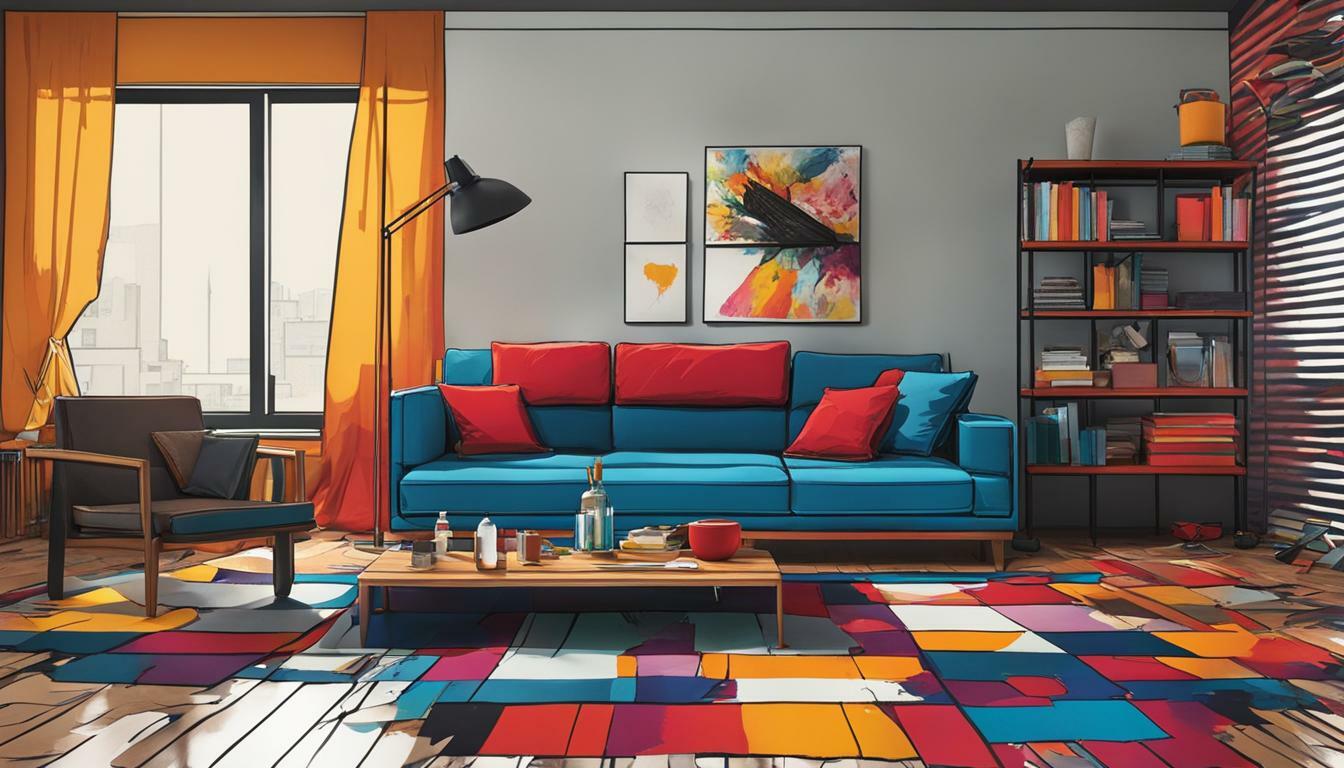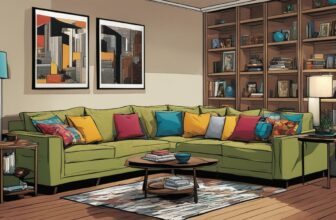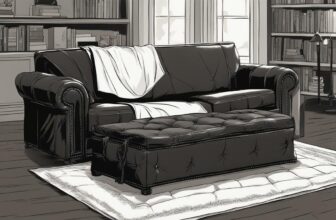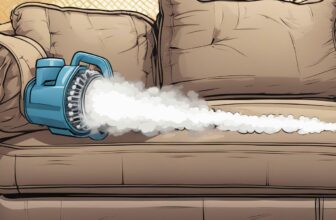
If you have come across a beautiful piece of upholstered furniture, such as a sofa or chair, that has great style but the color is not to your liking, dyeing is a great option to give it a whole new life and style. Dyeing a couch can be a cost-effective solution compared to buying a new one, and it allows you to customize the color to fit your aesthetic preferences. In this article, we will explore the steps and tips for dyeing a couch, focusing on fabric upholstered pieces.
Before we delve into the process, it is important to note that this tutorial is not applicable to slipcovered furniture or leather sofas. Slipcovered furniture with removable fabric covers can often be dyed in a washing machine or dye bath, while leather sofas require different methods. We will be using plain Rit dye on fabric for this tutorial.
Key Takeaways
- Dyeing a couch can be a cost-effective solution and allows you to customize the color to fit your aesthetic preferences.
- Finding a suitable sofa to dye can be done by exploring local thrift stores, antique shops, or online marketplaces.
- Before dyeing the sofa, thorough preparation is crucial. Clean the sofa using soapy water to remove any dust or dirt that may affect the dyeing process, and check for damages that might need repair before proceeding.
- When selecting the dye, consider a color that complements your room and existing decor. Industrial fabric paint or fabric paint mixed with textile medium is suitable for fabric sofas.
- The dyeing process involves working in small sections and applying thin coats of dye. Allow each coat to dry completely before applying additional coats.
Why Dye a Couch?
Why would you want to dye a sofa? There are several reasons why dyeing a sofa is a worthwhile endeavor. Antique or vintage furniture often has beautiful craftsmanship and character, but the existing color may not be appealing. Dyeing allows you to freshen up or completely change the color to better suit your taste. Additionally, dyeing is a cost-effective alternative to purchasing a new couch, which can be expensive and time-consuming to obtain.
Customization is another benefit of dyeing a sofa. By dying the fabric, you have the opportunity to create a one-of-a-kind piece that reflects your unique style and personality. Imagine having a sofa that perfectly complements the color scheme of your living room or a bold statement piece that adds character and interest to your home decor.
For those who appreciate the charm and history of antique or vintage furniture, dyeing a sofa can be a way to preserve its authenticity while still making it suitable for modern living. Instead of relegating a vintage sofa to a forgotten corner, dyeing can give it new life and purpose as a focal point in your home.
Overall, dyeing a couch is a cost-effective and creative way to transform the appearance of an upholstered piece of furniture, making it a worthwhile endeavor for those looking to spruce up their living space.
Finding a Suitable Sofa to Dye
Finding a suitable sofa to dye can be done by exploring local thrift stores, antique shops, or online marketplaces such as Facebook Marketplace, OfferUp, Craigslist, and NextDoor. Thrift stores and antique shops often have a rotating inventory, offering new options regularly. Estate sales and online platforms also provide opportunities to find unique and affordable pieces. It is recommended to shop during weekdays for the best selection, and to arrive early to snag the best deals. When considering a potential couch for dyeing, ensure that it is a fabric sofa rather than a leather one.
Factors to Consider Before Dyeing
Once you have found a suitable sofa, there are several factors to consider before proceeding with the dyeing process. The cost of the item is an important consideration, and it is advisable to keep the cost below $100 to minimize risk. While it is natural to feel the fear of missing out, remember that with time and perseverance, you will likely come across similar pieces in the future. Additionally, it is essential to check the compatibility of the fabric with the dye. Conduct a small test on a hidden portion of the sofa to ensure that the dye adheres properly without rubbing off or creating patches.
Other factors to keep in mind include minimizing the risk of damage, such as tears or holes in the fabric, and ensuring that the dye is compatible with the fabric’s texture and weave. Be sure to read the manufacturer’s instructions carefully before proceeding with the dyeing process.
Preparing the Sofa for Dyeing
Before dyeing the sofa, thorough preparation is crucial. It is important to clean the sofa properly to remove any dust or dirt that may affect the dyeing process. Use soapy water to clean the surface of the sofa and ensure it dries completely before proceeding with the dyeing process.
Next, check for damages that might need repair before proceeding. This includes repairing any tears, holes, or loose stitching. It is also important to remove the cushions if possible to dye them separately and ensure that they do not become discolored during the process.
To protect parts of the couch that you do not want to dye, use painter’s tape to cover wood or hardware. Also, be sure to work in a well-ventilated workspace, preferably in a basement, garage, or outdoor area. If you are working indoors, open windows and doors and use a fan for ventilation.
Remember, the key to getting a great result is in the preparation, so take your time and make sure everything is in order before moving on to applying the dye.
Selecting the Right Dye
When selecting the dye, consider a color that complements your room and existing decor. Industrial fabric paint or fabric paint mixed with textile medium is suitable for fabric sofas. Test the dye on a small section of the sofa to ensure compatibility with the fabric.
The Dyeing Process
The dyeing process involves working in small sections and applying thin coats of dye. Before starting, make sure to protect the areas of the couch you do not want to dye. Begin by spraying the fabric with water to help it absorb the dye better. Then, use a wool dauber or sponge to apply the dye evenly, using parallel strokes.
It is important to work in small sections to ensure that the dye is applied evenly and does not streak or leave patches. Remember to apply the dye thinly to avoid blotching and to allow the fabric to breathe and absorb the color.
After each coat, allow the sofa to dry completely before applying additional coats. The number of coats needed will depend on the desired color and the type of fabric on the sofa. Typically, two to three coats should suffice, but additional coats can be added for a darker, richer color.
Once the final coat has dried, apply a finisher to seal the dye and protect it from fading. The finisher will also help prevent the dye from rubbing off on clothing or other items that come into contact with the sofa.
Considerations for Leather Sofas
Keep in mind that hand-dyeing leather can result in a slightly uneven look, so expect some variations in color. It is also important to note that while dyeing can address the appearance of worn-down fabric, it will not fix any underlying structural issues. Assess the condition of the sofa and determine if it is better to replace it than attempt to spruce it up with dye.
Conclusion
In conclusion, dyeing a couch is a cost-effective and creative way to transform the appearance of an upholstered piece of furniture. By following the steps outlined in this tutorial, you can achieve a whole new look for your sofa. Remember to select a fabric sofa, test the dye compatibility, prepare the surface properly, and apply the dye in thin coats. With patience and attention to detail, you can enjoy a beautifully dyed couch that complements your home decor. So, go ahead and try dyeing your couch today to give it a new lease of life!
FAQ
Q: Can I dye a slipcovered couch or a leather sofa?
A: No, this tutorial is specifically for fabric upholstered couches. Slipcovered furniture with removable fabric covers can often be dyed in a washing machine or dye bath, while leather sofas require different methods.
Q: Where can I find a suitable sofa to dye?
A: You can explore local thrift stores, antique shops, or online marketplaces such as Facebook Marketplace, OfferUp, Craigslist, and NextDoor. Estate sales and online platforms also provide opportunities to find unique and affordable pieces. Just make sure to look for fabric sofas rather than leather ones.
Q: What factors should I consider before dyeing a sofa?
A: It’s important to keep the cost of the item below $100 to minimize risk. Additionally, conduct a small test on a hidden portion of the sofa to ensure that the dye adheres properly without rubbing off or creating patches.
Q: How do I prepare the sofa for dyeing?
A: Clean the sofa using soapy water to remove any dust or dirt. Check for damages that might need repair before proceeding, and remove the cushions if possible to dye them separately. Use painter’s tape to cover parts of the couch that you do not want to dye, and ensure that the workspace is well-ventilated.
Q: What type of dye should I use?
A: Industrial fabric paint or fabric paint mixed with textile medium is suitable for fabric sofas. Test the dye on a small section of the sofa to ensure compatibility with the fabric.
Q: How do I apply the dye?
A: Spray the fabric lightly with water before applying the dye to help it absorb better. Use a wool dauber or sponge to apply the dye evenly, working in parallel strokes. Allow each coat to dry completely before applying additional coats. The number of coats needed will depend on the desired color and the fabric of the sofa.
Q: Can I dye a leather sofa?
A: Dyeing leather can result in a slightly uneven look, so expect some variations in color. However, it is important to note that dyeing can only address the appearance of worn-down fabric and will not fix any underlying structural issues.





